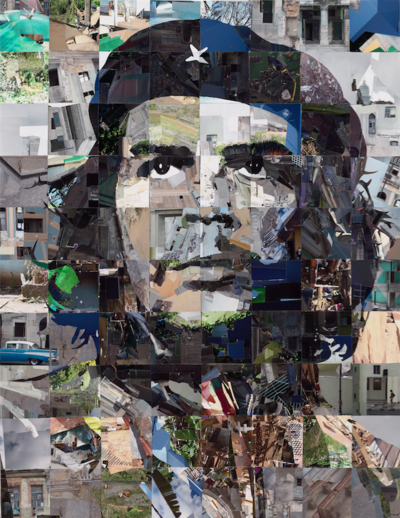Mark Guglielmo’s Portrait of Contemporary Cuba

Mark Guglielmo, “Che x Alberto Korda x Chuck Close,” 2016, photo-mosaic, 54 x 42″. All photos courtesy the artist.
By Olivia J. Kiers
Since President Obama lifted many of the travel restrictions to Cuba for U.S. citizens, exhibitions focusing on the island nation have appeared in museums and galleries throughout New England. Alongside works including the Afro-Cuban artist Maria Magdalena Campos-Pons’ Alchemy of the Soul installation for the Peabody Essex Museum last spring, numerous photography shows by American artists have cropped up, most claiming to reveal the “real” Cuba. In the midst of these latter shows, Mark Guglielmo’s exhibition Cuba in Transition: Narrative & Perspective at A.P.E. Ltd. Gallery in Northampton, MA, offers an alternate vision for what an American photographer traveling to Cuba could achieve.
While Guglielmo’s giant “photo-mosaics” (collaged together by hand rather than digitally) fill the walls with dizzying swirls of color and form, they resist airbrushing an impoverished nation. Neither do they condescend. In a work like El Coche Verde/The Green Car, Havana, Guglielmo’s camera catches an antique car and its owner/mechanic in Habana Vieja (Old Havana). One difference between this photo and many vintage-vehicle-in-Cuba shots is dirtiness. The car is in mid-repair, with trash in the foreground and crumbling buildings in the background. This is one scene a tour guide would avoid. Yet far more important than straying off the beaten path was Guglielmo’s choice to stay a while, entering into conversation with his subject and even returning to the site the next day to continue photographing (the same man can be seen wearing two different shirts).

Mark Guglielmo, “El Coche Verde | The Green Car, Havana,” 2016, photo-mosaic, 68 x 94″
“Narrative” is part of the exhibition’s title. “Dialogue” might have been a better choice—the exhibition is almost a collaboration between an American photographer and Cuban subjects. Included in the gallery are voice recordings of Cubans speaking with Guglielmo about Cuba’s history and its place in the world today. For those who don’t speak Spanish, there are printed English translations. Guglielmo resists infantilizing: he gives his Cuban subjects a level of agency and complexity usually absent in American photography, which all too often skims the surface in search of the picturesque.
Instead, Guglielmo is incredibly knowledgeable of Cuba’s history, and presents it in a non-confrontational way that might feel new to an American audience, such as his Chuck Close-inspired photo-mosaic of Alberto Korda’s famous image of Che Guevara, Che x Alberto Korda x Chuck Close. In 2018, Cuba in Transition will travel to Galéria de Arte Boulevard in Cienfuegos, Cuba and Galéria de Arte Universal in Trinidad, Cuba, after its time in Northampton—a real feather in the cap for both the artist and the show’s curator, Puerto-Rican native Waleska Santiago-Centeno. Something of this attitude of exchange and the opening of hidden worlds is evident in the mesmerizing Escuela Primaria, taken after Guglielmo convinced a primary school to let him show up for morning assembly and document it.

Mark Guglielmo, “Escuela Primaria,” photo-mosaic.
Cuba in Transition is also, quite simply, wonderful to look at. Caribbean colors are on full display, and Guglielmo’s collage method—with which he has been experimenting since high school—is witty. New information is constantly revealing itself in each work. Streets are warped to reveal what lies around the corner. An overall pattern of light and dark echoes the tiny eye of a painter’s shop logo. A scrap of trash reveals itself to be—up close—a tiny couple holding hands. This, married to the nuanced treatment of its subject and inclusion of Cuban voices, creates a show that deserves to be seen in person, especially by anyone interested in the “real Cuba.”
Cuba in Transition is on view at A.P.E. Ltd. Gallery through June 25.
